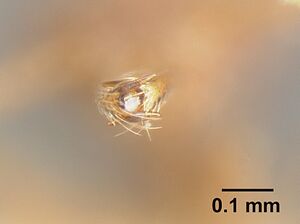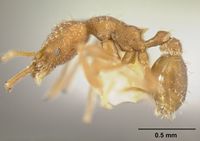Strumigenys dubitata
| Strumigenys dubitata | |
|---|---|

| |
| Scientific classification | |
| Kingdom: | Animalia |
| Phylum: | Arthropoda |
| Class: | Insecta |
| Order: | Hymenoptera |
| Family: | Formicidae |
| Subfamily: | Myrmicinae |
| Tribe: | Attini |
| Genus: | Strumigenys |
| Species: | S. dubitata |
| Binomial name | |
| Strumigenys dubitata Bolton, 2000 | |
Specimens have been collected from dry forest litter samples.
Identification
Bolton (2000) - A member of the Strumigenys louisianae-group. As in Strumigenys infidelis the humeral hair in dubitata is stiff and not flagellate. However, dubitata has two pairs of erect short hairs on the vertex, an obtuse and shallow postbuccal groove and a small posterior spongiform lobe ventrally on the petiole. In infidelis only a single pair of standing hairs occurs on the vertex, the postbuccal groove is narrow and deeply incised and the petiole ventrally completely lacks spongiform tissue.
Longino (Ants of Costa Rica) - Apical fork of mandible with two intercalary teeth; a conspicuous preapical tooth just proximal to the apical fork, and a preapical denticle about one third of mandible length from apical fork; outstanding setal pairs on sides of head, humeral angles, and mesonotum all similar, stiff and weakly thickened apically; gaster finely granular, opaque; erect setae on gaster spatulate; posterior face of petiolar node quadrate in posterior view, with produced anterolateral corners.
Keys including this Species
Distribution
Latitudinal Distribution Pattern
Latitudinal Range: 10.88674° to 10.84479°.
| North Temperate |
North Subtropical |
Tropical | South Subtropical |
South Temperate |
- Source: AntMaps
Distribution based on Regional Taxon Lists
Neotropical Region: Costa Rica (type locality).
Distribution based on AntMaps
Distribution based on AntWeb specimens
Check data from AntWeb
Countries Occupied
| Number of countries occupied by this species based on AntWiki Regional Taxon Lists. In general, fewer countries occupied indicates a narrower range, while more countries indicates a more widespread species. |

|
Estimated Abundance
| Relative abundance based on number of AntMaps records per species (this species within the purple bar). Fewer records (to the left) indicates a less abundant/encountered species while more records (to the right) indicates more abundant/encountered species. |

|
Biology
|
Castes
Images from AntWeb

| |
| Paratype Strumigenys dubitata. Worker. Specimen code inbiocri001283963. Photographer D. J. Cox, uploaded by California Academy of Sciences. | Owned by JTLC. |
Nomenclature
The following information is derived from Barry Bolton's Online Catalogue of the Ants of the World.
- dubitata. Strumigenys dubitata Bolton, 2000: 523, figs. 312, 341, 353 (w.) COSTA RICA.
Unless otherwise noted the text for the remainder of this section is reported from the publication that includes the original description.
Description
Worker
Holotype. TL 2.5, HL 0.60, HW 0.52, CI 87, ML 0.34, MI 57, SL 0.38, SI 73, PW 0.31, AL 0.62. Mandible with a minute inconspicuous denticle proximal to the preapical tooth, located on the upper inner margin just distal of its midlength. With head in profile postbuccal groove shallow and obtuse. Apicoscrobal hair short and stiff, weakly remiform. Cephalic dorsum with two pairs of short standing hairs, one close to occipital margin, the other close to highest point of vertex. Pronotal humeral hair stiff and more or less straight, simple to very narrowly remiform; mesonotal standing hairs simple to narrowly remiform. Ventral surface of petiole with a small spongiform lobe posteriorly below the node; when postpetiole flexed downward this lobe is concealed between the ventral lobes of the postpetiole.
Paratypes. TL 2.4-2.6, HL 0.57-0.64, HW 0.46-0.54, CI 81-87, ML 0.32-0.36, MI 54-57, SL 0.35-0.41, SI 72-78, PW 0.29-0.32, AL 0.57-0.66 (7 measured). As holotype but preapical denticle may be difficult to see.
Type Material
Holotype worker, Costa Rica: Provo Guanacaste, Guanacaste N. P., Santa Rosa Sector, iv.1985 (J. Memmott) (The Natural History Museum).
Paratypes. Costa Rica: 2 workers with same data as holotype; 1 worker, Provo Guanacaste, Santa Rosa N. P., 10°51'N, 85°37 'W, 300 m., 11-15.vii.1985, dry forest, #519-S (J. Longino); 2 workers with same data but 12.vii.1985, #420-S (J. Longino); 3 workers, Provo Guanacaste, La Pacifica, 40 m., 10°27' N, 85°08'W, 16-17.vii.1985, dry forest litter sample, #530-S (J. Longino) (BMNH, Instituto Nacional de Biodiversidad, Museum of Comparative Zoology, Museu de Zoologia da Universidade de Sao Paulo, John T. Longino Collection).
References
- Bolton, B. 2000. The ant tribe Dacetini. Memoirs of the American Entomological Institute. 65:1-1028. (page 523, worker described)
References based on Global Ant Biodiversity Informatics
- Fernández, F. and S. Sendoya. 2004. Lista de las hormigas neotropicales. Biota Colombiana Volume 5, Number 1.
- INBio Collection (via Gbif)
- Ulyssea M. A., C. R. F. Brandao. 2013. Catalogue of Dacetini and Solenopsidini ant type specimens (Hymenoptera, Formicidae, Myrmicinae) deposited in the Museu de Zoologia da Universidade de Sao Paulo, Brazil. Papies Avulsos de Zoologia 53(14): 187-209.

